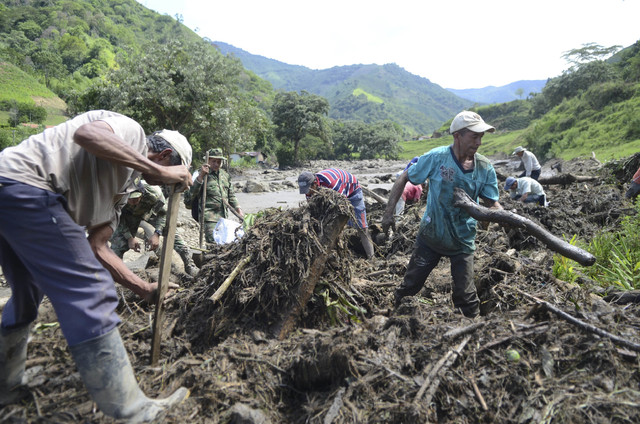SALGAR, Colombia (AP) — An avalanche of mud and debris roared over an alpine town in western Colombia before dawn Monday, killing at least 52 people in a flash flood and mudslide triggered by heavy rains. ADVERTISING SALGAR, Colombia (AP)
SALGAR, Colombia (AP) — An avalanche of mud and debris roared over an alpine town in western Colombia before dawn Monday, killing at least 52 people in a flash flood and mudslide triggered by heavy rains.
Residents were stirred from bed in the dead of the night by a loud rumble and neighbors’ shouts of “The river! The river!” as modestly built homes and bridges plunged into the Libordiana ravine. Survivors barely had enough time to gather their loved ones.
“It was rocks and tree trunks everywhere,” Diego Agudelo told The Associated Press, adding that never in 34 years living next to the ravine had he suspected such a tragedy was possible.
“The river took out everything in its path,” the construction worker said, including the back part of his home.
The disaster hit around 3 a.m. local time (4 a.m. EDT; 0800 GMT) in the town of Salgar, about 60 miles (100 kilometers) southwest of Medellin.
Dozens of rescuers supported by Black Hawk helicopters evacuated residents near the ravine for fear of another mudslide. A red fire truck could be seen hauling away several bodies, their bare feet dangling from an open trunk.
President Juan Manuel Santos, who traveled to the town to oversee relief efforts, said several children lost their parents and the bodies of those killed needed to be transported to Medellin to be identified. As giant diggers were removing debris he vowed to rebuild the lost homes and provide shelter and assistance for the estimated 500 people affected by the calamity.
“Nobody can bring back the dead … but we have to handle this disaster as best we can to move forward,” Santos said.
Authorities said that 52 people were confirmed dead but that the number could rise. Dozens have suffered light injuries and an unknown number of people are still unaccounted for.
Colombia’s rugged topography, in a seismically active area at the northern edge of the Andes, combined with shoddy construction practices, has made the country one of Latin America’s most disaster-prone. More than 150 disasters have struck the country over the past 40 years, claiming more than 32,000 lives and affecting more than 12 million people, according to the Inter-American Development Bank.
The tragedy in Salgar appeared to be the single deadliest event since a 1999 earthquake in the city of Armenia that left hundreds dead. A wave of flooding during the 2011 rainy season left more than 100 dead.
Luz Maria Urrego, 74, said she escaped certain death because she had traveled to Medellin for the long holiday weekend. She said her brother was killed along with his children and grandchildren.
“I said to my wife ‘let’s hold each and hope that God saves us,’” said Jorge Quintero, a local resident, describing to RCN TV how he was trapped between two raging currents that had taken with it two homes on either side of his own. “I know God gave us his hand because here we are, alive, still frightened, but alive.”
The flooding destroyed the town’s aqueduct and even areas in less hazardous zones experienced flooding. As a cautionary measure, electricity and other public services were suspended after several utility poles were knocked down.
Authorities called on volunteers to send water, food supplies and blankets to cope with what they described as a humanitarian emergency.
The town of 18,000 lies amid one of Colombia’s major coffee-growing regions. Former President Alvaro Uribe, who spent part of his childhood in Salgar, where his mother was born, rushed to the town to assist in relief efforts.
“It’s very painful what we’ve seen,” he told RCN TV, describing his encounter with a grandmother caring for her 3-day-old grandchild in place of the boy’s parents, who are missing.



